Rob Bell's Blog, page 5
July 31, 2023
4 Fast Skills On How To Become More Patient (INFOGRAPHIC)
“Patience is not an absence of action. It is a purposeful choice to wait.” – Salman Ahktar
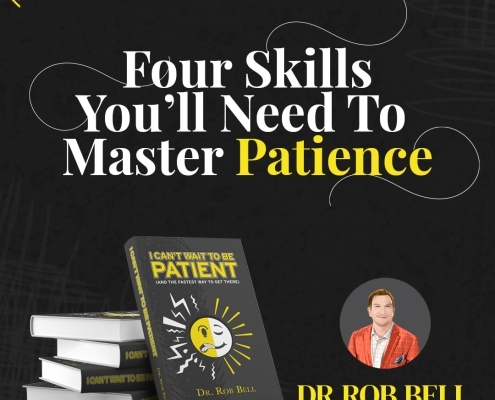
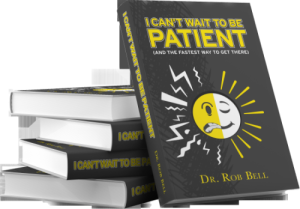
Check out our new book:
The mental game and mental toughness is more about subtraction than it is addition. Removing anger, frustration, fear, and/or annoyances from our daily lives is difficult. However, doing so also improves our disposition, grit, and attitude.
More importantly, when we learn how to become more patient, it also builds up one’s capacity to handle and endure future disappointment, rejection, and failure.

Ask yourself this question, “does more pain come from letting go or resisting?”
Acceptance of things and people as they are is difficult.
It’s why we all get stuck. Not many of us want to accept that we get older, for instance.
Not many accept being wrong or changing their mind. Few want to accept death and heartache as part of life. Few want to accept that life is not fair. It is painful to lose material possessions, friends, jobs, houses, money, championships, etc.
It’s even worse and more difficult to accept when we are cheated or swindled.
Acceptance of change in our life is difficult. Our goals change, our kids change, our finances change, our relationships change, etc. But since time is the only constant, our view and actions within time need to change as well.
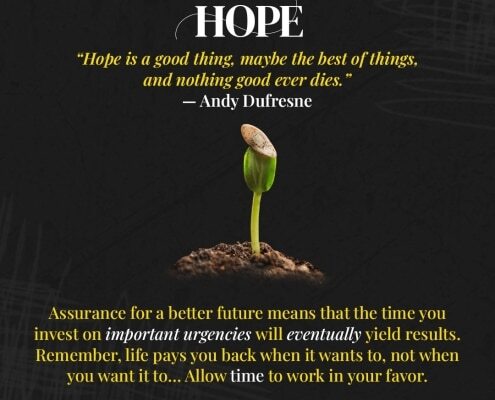
When the greats in any field know that they have what it takes and are confident in their own process, it provides a level of assurance for a better future.
Confidence means they have an attitude of “when” not “if” the results will manifest.
Confidence and patience work in tandem. When we are confident, we are able to have more patience. And when we are patient, it allows us to be confident.
That is why HOPE is a source of how to become more patient.
When we have patience with the product, it grants us perspective with the process.
When we “can’t wait” and force or manipulate a situation or person, it also reveals our own level of confidence and patience.
We need to be urgent with the process, but patient with the results.
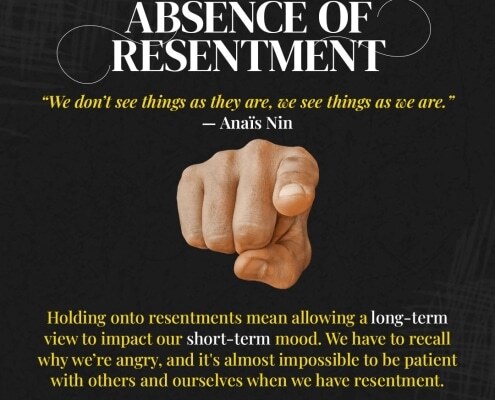
An absence of resentment means we have to examine our role in any given situation. We can’t change the outcome or other people without understanding our own insecurities and baggage in a situation.
It starts with us.
To possess an absence of resentment means to approach people, situations, and especially ourselves with patience.
If we have resentment toward ourselves for a past setback, then we will develop resentment towards others.
It’s a simple formula of “arrows in” also means “arrows out.”
Hurt people will hurt other people because the cycle of resentment is so powerful.
If we don’t transform our past pain, then we will transmit it to others closest to us.
In order to be patient, we must develop an absence of resentment towards others and ourselves. When we do this, time again begins to work in our favor and removes that hurt we held onto.
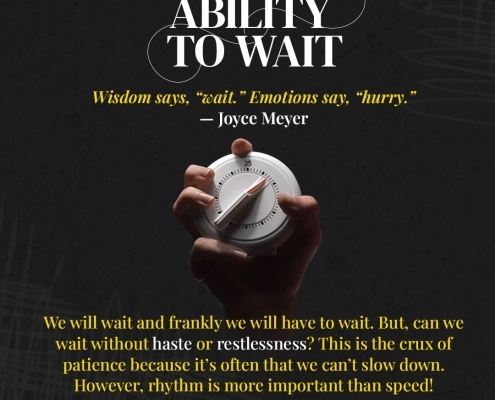
The ability to wait without haste or restlessness seems to be the core concept of how to become more patient. It’s what I am probably worst at.
We feel like we can’t slow down, because we perceive everything as urgent.
The crux of patience is that we have become urgent toward the un-important. Our emotions and mood tell us that it is important in the short-term, but with time, the urgent cannot be coupled with the unimportant.
We don’t wait. We scroll…
We don’t wait. We scroll…
Click To Tweet
We delete emails, mindlessly scroll social sites, text others, post videos, etc.
When we awake in the morning, we are often at odds with our own sense of urgency. And this sense of urgency is usually toward the unimportant.
Patience won’t always win it for you, but if you don’t have patience, it will lose it for you.
Patience won’t always win it for you, but if you don’t have patience, it will lose it for you.
Click To Tweet
 Dr. Rob Bell is a Sport Psychology Coach. DRB & associates coach executives and professional athletes. Some clients have included three different winners on the PGA Tour, Indy Eleven, University of Notre Dame, Marriott, and Walgreens.
Dr. Rob Bell is a Sport Psychology Coach. DRB & associates coach executives and professional athletes. Some clients have included three different winners on the PGA Tour, Indy Eleven, University of Notre Dame, Marriott, and Walgreens.
Check Out All The Books
Keynote Speaking On Mental Toughness
Mental Toughness Podcast as we interview expert athletes and coaches about Mental Strength and their Hinge Moment.
New Blog Posts are published weekly.
Follow on Twitter @drrobbell
Follow on Instagram @drrobbell
July 23, 2023
Here’s Why Urgency and Patience Are Both Needed For Success (INFOGRAPHIC)
Urgency is defined as requiring swift action. It means acting with clarity and purpose.
Urgency is also a state of the internal, not a state of the external. Inside of our own lives, urgency is a necessary ingredient for production, performance and success.
As Hall of Fame Coach Wooden often stated, “Be quick, but don’t hurry. I want quickness under control.”
Here’s Why Urgency and Patience Are Both Needed For Success (INFOGRAPHIC)The issue is, by itself, urgency is a lunatic.
We can be urgent toward EVERYTHING. In the least, we are urgent toward too many things and then there’s no off switch and life happens and we can’t ever seem to catch up. Urgency is only best when it is focused execution of the important.
We need to know when to be urgent and how to be patient.Because of the importance, power, and relativity of time, patience is the path. It allows us the space and time to decide what’s most important and uncover what is of less importance.
This path of patience embodies an increased awareness of time, a relationship with the important urgencies, and an elimination of the stress, worry, and hurry that we carry with us.
With patience, our entire attitude and outlook will change.
“A moment of patience in a moment of anger can save a hundred moments of regret.” — Elbert Hubbard
Check out our new book:
This infographic is a reminder of the balance between urgency and patience and the power of time.
The chart is not incorrect, but it is incomplete. You may live longer or you may live shorter than 80 years. Based on a lifetime of eighty years of life, there are 29,220 days. Depending on our age, there are a certain number of days remaining.
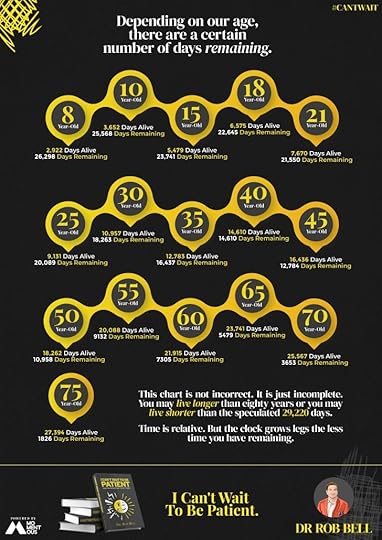
However, we simply don’t know when is the end of the game. How you seize and maximize your days alive will be dependent upon your ability to be urgent toward the important and patient with the product. Hence, urgency and patience.
8-year-old = 2,922 days alive = 26,298 days remaining10-year- old = 3,652 days alive = 25,568 days remaining15-year-old = 5,479 days alive = 23,741 days remaining18-year-old = 6,575 days alive = 22,645 days remaining21-year-old = 7,670 days alive = 21,550 days remaining25-year-old = 9,131 days alive = 20,089 days remaining30-year-old = 10,957 days alive = 18,263 days remaining35-year-old = 12,783 days alive = 16,437 days remaining40-year-old = 14,610 days alive = 14,610 days remaining45-year-old = 16,436 days alive = 12,784 days remaining50-year-old = 18,262 days alive = 10,958 days remaining55-year-old = 20,088 days alive = 9132 days remaining60-year-old = 21,915 days alive = 7305 days remaining65-year-old = 23,741 days alive = 5479 days remaining70-year-old = 25,567 days alive = 3653 days remaining75-year-old = 27,394 days alive = 1826 days remainingUrgency and patience are both essential skills needed for success and to enjoy life.
We can’t be so bothered by our number of days remaining, that we don’t strive to be useful, dedicated, and positive towards others and especially ourselves.
Supply and demand is a cornerstone of economic theory. Prices increase with less supply, coupled with more demand.
Time fits within the supply and demand paradigm. When we are young or younger, we have unlimited supply of time and little demand. Hence, the price or value we place on it is inexpensive. The older we get, however, the less supply of time that we have, and the time demands increase. Hence, as we age, we place a much higher value on time.
The power of time is why we need to couple urgency and patience together as we travel in life, so we can stay focused, relaxed, and confident.
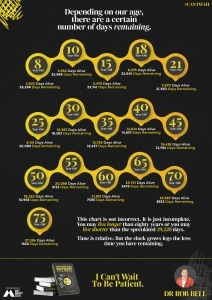
 Dr. Rob Bell is a Sport Psychology Coach. DRB & associates coach executives and professional athletes. Some clients have included three different winners on the PGA Tour, Indy Eleven, University of Notre Dame, Marriott, and Walgreens.
Dr. Rob Bell is a Sport Psychology Coach. DRB & associates coach executives and professional athletes. Some clients have included three different winners on the PGA Tour, Indy Eleven, University of Notre Dame, Marriott, and Walgreens.
Check Out All The Books
Keynote Speaking On Mental Toughness
Mental Toughness Podcast as we interview expert athletes and coaches about Mental Strength and their Hinge Moment.
New Blog Posts are published weekly.
Follow on Twitter @drrobbell
Follow on Instagram @drrobbell
July 15, 2023
The Only Mental Toughness Quote You’ll Need To Prepare

William James once said, “Do something every day for no other reason than you’d rather not do it.”
There’s two parts to this quote: He added…
“For when the hour of dire need draws nigh, it may find you not unnerved and untrained to stand the test.”
Boom!
Why Is This The ONLY Mental Toughness Quote You Need For Preparation?The motivation is simple:
Do it, because it’s tough…Do it because you don’t want to listen to that negative voice…Just do it..However, it is not devoid of a reason.
There is purpose to doing hard things.
The real purpose is that strength is needed in life. And there are major challenges and setbacks…How will you overcome and handle yourself during those extremely tough periods of your journey?
How you will respond will be a direct result of how you’ve trained and how you’ve prepared.
My friend Jerred Moon says “Kill Comfort, or comfort will kill you.”I was on his podcast recently.
Do something. Anything. Do something that challenges you and know that it does have purpose to it. Just as Bob Dylan says “He not busy being born, is busy dying.”
Few suggestions on activities that’ll help with preparation:
Cold Shower Run Drive a different way home Call an old friend Read a Book Ask for a Discount Speak to an audienceDo you want anothermental toughness quote?
“If It doesn’t challenge you, it doesn’t change you!”
 Dr. Rob Bell is a Sport Psychology Coach. DRB & associates coach executives and professional athletes. Some clients have included three different winners on the PGA Tour, Indy Eleven, University of Notre Dame, Marriott, and Walgreens.
Dr. Rob Bell is a Sport Psychology Coach. DRB & associates coach executives and professional athletes. Some clients have included three different winners on the PGA Tour, Indy Eleven, University of Notre Dame, Marriott, and Walgreens.
Check Out All The Books
Keynote Speaking On Mental Toughness
Mental Toughness Podcast as we interview expert athletes and coaches about Mental Strength and their Hinge Moment.
New Blog Posts are published weekly.
Follow on Twitter @drrobbell
Follow on Instagram @drrobbell
June 11, 2023
What D-Day Can Teach Us About The Importance Of Patience In Life
Dwight D. Eisenhower was a Five-Star General of the United States Army and during WWII and he served as supreme commander of allied forces.
He was in charge of it all.
He was tasked to lead the D-Day invasions to liberate Europe and it was simply the largest land invasion force in history. Naval, air, and ground forces were all needed to work in unison for the mission to be successful.
The invasion was described as an intricate jigsaw puzzle, which each piece needed to fit perfectly. Therein involved an obsessive amount of preparation, planning, and attention to detail, with the highest of stakes.
Herein lies the importance of patience in life.
The puzzle of the D-Day invasions also involved several allied countries and the world’s greatest political and military leaders. The egos, agendas, and the global leaders need for recognition led to critical complexity.
Besides the when, where, and mass secrecy needed for the amphibious landing, nothing had been left to chance.
Operation Overlord was the code name for the invasion that involved approximately 156,000 American, British, & Canadian forces along five separate beaches across a 50-mile stretch in France.
To help illustrate the complexity of Operation Overlord, in less than one month, over 850,000 soldiers, 570,000 tons of supplies, and 148,000 vehicles landed in Normandy, France.
However, even though everything had been accounted for, there was one piece that was out of their control.
The weather.
The importance of patience in life and whether D-Day was to be successful depended upon optimal weather. Low tide, light wide, and good visibility were essential to success.
But, the weather outlook was not favorable and modern day technology was not available for forecasting. The weather outlook was so poor that many of the top German generals had taken leave away from the front lines and the possible invasions. Can you imagine? They “couldn’t wait” to take a break.
General Eisenhower and others had to wait…It wasn’t until the day before on June 5th, that the order been given to proceed with Operation Overlord.
June 6th looked like the only opportunity for weeks.
Patience is the new mental toughness!
Check out our new book:
D-Day marked the start of the end of WWII and by the end of August 1944, the Nazi army was in full retreat out of France.
No one likes to wait, but we will have to wait in life. Eisenhower’s ability to wait for the latest weather is in part what allowed the allies to have such success!
The importance of patience in life is if you can wait, then you can win!
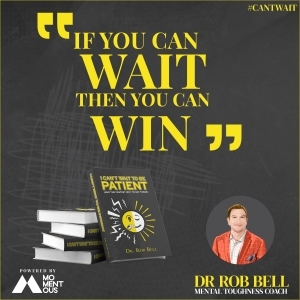
Life and success is a game of attrition and timing. There will be times of “important urgencies” as well as times of waiting. Both are essential.
The skill becomes knowing WHEN to be urgent and HOW to be patient!
Patience is essential! Have you ever drank wine before it’s ready?
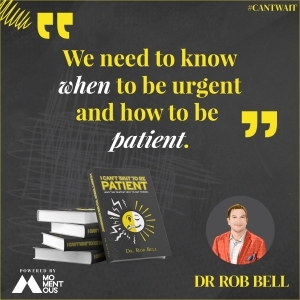
The results we want are always a long-term campaign. Just like the D-Day invasions, proper planning and patience is required.
One ingredient called for within the recipe of success always includes short-term sacrifice for long-term achievement. Patience and over-valuing the long-term means going beyond time management hacks and tactics.
However, waiting in the short-term causes us to feel discomfort, unease, or uncertainty. The short-term is over-scrutinized and over-analyzed. The short-term focus isn’t incorrect, but it is incomplete. Hence, the short-term is simply a snapshot, not an entire movie.
Issues arise when we only focus on the short-term.
We immediately extrapolate it into the long-term. We think and act that just because the short-term is good or bad, then it will continue that way. We speculate and fast-forward through all of the positive and negative scenarios and outcomes.
The importance of patience in life is because we can’t fast-forward success or results.
 Dr. Rob Bell is a Sport Psychology Coach. DRB & associates coach executives and professional athletes. Some clients have included three different winners on the PGA Tour, Indy Eleven, University of Notre Dame, Marriott, and Walgreens.
Dr. Rob Bell is a Sport Psychology Coach. DRB & associates coach executives and professional athletes. Some clients have included three different winners on the PGA Tour, Indy Eleven, University of Notre Dame, Marriott, and Walgreens.
Check Out All The Books
Keynote Speaking On Mental Toughness
Mental Toughness Podcast as we interview expert athletes and coaches about Mental Strength and their Hinge Moment.
New Blog Posts are published weekly.
Follow on Twitter @drrobbell
Follow on Instagram @drrobbell
window.addEventListener('LPLeadboxesReady',function(){LPLeadboxes.addDelayedLeadbox('WPM9ibP3euzHNXNXvL4RnZ',{delay:'30s',views:0,dontShowFor:'0d',domain:'drrobbell.lpages.co'});});
The Sheer Importance Of Patience In Life |
Dwight D. Eisenhower was a Five-Star General of the United States Army and during WWII and he served as supreme commander of allied forces.
He was in charge of it all.
He was tasked to lead the D-Day invasions to liberate Europe and it was simply the largest land invasion force in history. Naval, air, and ground forces were all needed to work in unison for the mission to be successful.
The invasion was described as an intricate jigsaw puzzle, which each piece needed to fit perfectly. Therein involved an obsessive amount of preparation, planning, and attention to detail, with the highest of stakes.
Herein lies the importance of patience in life.
The puzzle of the D-Day invasions also involved several allied countries and the world’s greatest political and military leaders. The egos, agendas, and the global leaders need for recognition led to critical complexity.
Besides the when, where, and mass secrecy needed for the amphibious landing, nothing had been left to chance.
Operation Overlord was the code name for the invasion that involved approximately 156,000 American, British, & Canadian forces along five separate beaches across a 50-mile stretch in France.
To help illustrate the complexity of Operation Overlord, in less than one month, over 850,000 soldiers, 570,000 tons of supplies, and 148,000 vehicles landed in Normandy, France.
However, even though everything had been accounted for, there was one piece that was out of their control.
The weather.
The importance of patience in life and whether D-Day was to be successful depended upon optimal weather. Low tide, light wide, and good visibility were essential to success.
But, the weather outlook was not favorable and modern day technology was not available for forecasting. The weather outlook was so poor that many of the top German generals had taken leave away from the front lines and the possible invasions.
General Eisenhower and others had to wait…It wasn’t until the day before on June 5th, had the order been given to proceed with Operation Overlord. June 6th looked like the only opportunity for weeks.
D-Day marked the start of the end of WWII and by the end of August 1944, the Nazi army was in full retreat from France.
No one likes to wait, but we will have to wait in life. Eisenhower’s ability to wait for the latest weather is in part what allowed the allies to have such success!
The importance of patience in life is if you can wait, then you can win!

Life and success is a game of attrition and timing. There will be times of “important urgencies” as well as times of waiting. Both are essential.
The skill becomes knowing WHEN to be urgent and HOW to be patient!
Patience is essential! Have you ever drank wine before it’s ready?

The results we want are always a long-term campaign. Just like the D-Day invasions, proper planning and patience is required.
One ingredient called for within the recipe of success always includes short-term sacrifice for long-term achievement. Patience and over-valuing the long-term means going beyond time management hacks and tactics.
However, waiting in the short-term causes us to feel discomfort, unease, or uncertainty. The short-term is over-scrutinized and over-analyzed. The short-term focus isn’t incorrect, but it is incomplete. Hence, the short-term is simply a snapshot, not an entire movie.
Issues arise when we only focus on the short-term.
We immediately extrapolate it into the long-term. We think and act that just because the short-term is good or bad, then it will continue that way. We speculate and fast-forward through all of the positive and negative scenarios and outcomes.
The importance of patience in life is because we can’t fast-forward success or results.
 Dr. Rob Bell is a Sport Psychology Coach. DRB & associates coach executives and professional athletes. Some clients have included three different winners on the PGA Tour, Indy Eleven, University of Notre Dame, Marriott, and Walgreens.
Dr. Rob Bell is a Sport Psychology Coach. DRB & associates coach executives and professional athletes. Some clients have included three different winners on the PGA Tour, Indy Eleven, University of Notre Dame, Marriott, and Walgreens.
Check Out All The Books
Keynote Speaking On Mental Toughness
Mental Toughness Podcast as we interview expert athletes and coaches about Mental Strength and their Hinge Moment.
New Blog Posts are published weekly.
Follow on Twitter @drrobbell
Follow on Instagram @drrobbell
May 30, 2023
4 Simple Ways: How To Achieve Patience
We are designed to get from point A to point B as quickly as possible.
To illustrate, which program would you buy?
How to be rich in 90 days or less?Or
How to be rich in 7-9 years?This illustrates the appeal that speed has in our lives.
We assume speed and quickness equates to an easier path. We look at the example above and think of the time rather than the product. Seriously, who wouldn’t want a faster way?
We do not get in our car, plug in the GPS, and pick the slowest path. Life is the same way; we are built to start our journey and reach the mountaintop of results as efficiently as possible.
We value speed and quickness!
The importance we place on speed is also how we value time. And our hardwiring itself suggests that the speed of time is the most valuable resource. Society relishes and romanticizes ultra-high-speed and quickness.
Tools such as “Insta,” “mobile ordering,” “5G or 6G or 7G internet speed,” “binge watching,” “same-day delivery,” “artificial intelligence,” and “live betting” have all made such activities in life way faster and seemingly more convenient.
These examples reveal the massive increase of speed in society as a whole. Technology has quickened the rhythm of life. And as a result of increased tempo and cadence of life, our patience has decreased.
Before we look at how to achieve patience, we must ask ourselves “why.”
When access to goods, people, and services are readily available, “Why” should we have patience?
“Life” is complex with kids, travel, bank accounts, appointments, and activities. Burned out, overwhelmed, worried, rushed, and tired are descriptors that are common and relatable. Society as a whole has reported that we are more rushed, hurried, anxious, and pressed for time than during any other time period.
It has also been reported a “time famine” exists because there is simply too much to do.
The irony is that we have more available ‘time’ to us now than at any point in history. We possess more leisure time than ever before. However, because we are programmed for quickness, our leisure time has even sped up.
But many think of time as an opponent. It must become an ally, not an opponent, in order to win the challenges we face. The product takes patience, and no matter how much we adore speed and quickness, we can’t fast forward the process. How can I increase my patience?
Patience is the path to our overall mental health, mental wellness, and performance.
Patience is the new mental toughness!
Check out our new book:
4 Simple Ways On How To Achieve Patience1.Patience is a process, not a destination.
There will be tests and teachers of patience, but one never actually arrives at “Hey, I’m patient.” We merely become better and well-equipped at handling, dealing, and coping with the stressors of life. Situations and circumstances vary.
The more over-whelmed we become, the more patience we need.
The Sheer Power of Patience and Wealth
2.This too shall pass
If things are going poorly, remember, this too shall pass.
If things are going great, unfortunately, this too shall pass.
We can’t have it both ways.
The relationship with how to achieve patience must be rooted in acceptance. We must accept situations as temporary, both good and bad. We must accept situations and people as they are, not as we shall have them. And this is tough!
Patience is intended as a liberator of your circumstances. Time is our most precious resource and acceptance of this fact should be freeing.
3.Focus on rhythm, not speed
Stress is a result of not being able to slow down.
It’s caused by too much time spent on the unimportant. Anxiety occurs when our mind is flooded with a meteor shower of “what-ifs.” There’s a better path instead of focusing on the speed from point A to point B.
Rhythm is quickness under control.
Routines can help create rhythm and a proper cadence of life.
There are natural routines that we do on the daily, from waking up, exercising, or brushing our teeth. Meetings, events, and even important decisions can have a rhythm to them and the most efficient ones have a familiar routine and structure.
4.Plan for flow
Flow happens naturally, we can’t force it.
However, we can put ourselves into situations that require our sole focus and attention.
The fastest way on how to achieve patience is to plan out your week, the Sunday evening before, or just plan for the next day ahead. There will be head winds and adjustments, but it will help keep the main thing the main thing.
We need to plan for times when we will be totally immersed into the daily activities at hand. This helps allow for our rhythm to unfold.
The largest obstacle of flow is the starting and stopping of trivial actions. The task switching or context switching stems from replying to emails, calls, or commenting on LinkedIn, and taking five minutes here and there. These interruptions interfere with the major goal, which is total immersion into the task at hand. However, the more often we switch, the more it tasks our mental energy.
We can better achieve flow and being in the moment by starting small and allowing increments of time to focus (e.g. for the next thirty minutes, I will stay completely immersed in the activity at hand with no interruptions or distractions).
Check out our new book:
 Dr. Rob Bell is a Sport Psychology Coach. DRB & associates coach executives and professional athletes. Some clients have included three different winners on the PGA Tour, Indy Eleven, University of Notre Dame, Marriott, and Walgreens.
Dr. Rob Bell is a Sport Psychology Coach. DRB & associates coach executives and professional athletes. Some clients have included three different winners on the PGA Tour, Indy Eleven, University of Notre Dame, Marriott, and Walgreens.
Check Out All The Books
Keynote Speaking On Mental Toughness
Mental Toughness Podcast as we interview expert athletes and coaches about Mental Strength and their Hinge Moment.
New Blog Posts are published weekly.
Follow on Twitter @drrobbell
Follow on Instagram @drrobbell
December 19, 2022
The Sheer Power Of Patience And Money
Rich people have money, but wealthy people have time. The power of time is how one creates real wealth. Wealthy people use their money to actually have more available time.
The main principle behind wealth is patience and money.
Warren Buffet said it best when asked by fellow billionaire, Jeff Bezos, why everyone doesn’t adopt his simple investment strategy, he said, “ because no one wants to get rich slow.”
Warren Buffet’s net worth at age 36 was approximately 8 million dollars. Not a bad nest egg, however, that level of wealth is around Jimmy Buffett’s net worth. Eight million is not a reason why you know Warren Buffet’s name.
With time, by age 56, Warren Buffet’s net worth was estimated at 1.4 billion. And by age 66, his wealth had increased to 17 billion.
His wealth from age 90 has risen to approximately $93-100 billion dollars.
Example #1 The Power of Patience and Money
If one just started investing just $13 a day at the age of 23, assuming a return rate of 6%, they will become a millionaire by age of 67. If one started investing at age 35, one would need to save $30 a day for the same return by age 67. And if someone waited until the age of 45, it would take $63 per day to reach millionaire status by age 67.
The reason why time is so powerful is through compounding. Compound interest causes wealth to accumulate because one not only earns on money invested, but one also earns returns on those returns.
Compounding is patience in action.
Example #2 The Power of Patience and Money
If one invested, $1000 in AAPL stock (Apple) in 1980, that investment would be worth 1.4 million in 2023, forty or so years later. And that does not included dividend payments or splits of the stock. However, if one invested $10,000 at the stock offering of AAPL, that money would have increased to $14 million dollars.
That is the sheer kick-ass power of time.
And one would not have had to be clairvoyant to experience the power of time. If one invested $1000 in the S&P 500 in the year of 1980, that investment today would be worth approximately $100,000.
Time grants money so much power that the stock market has never lost money. With time as a partner, the stock market has never lost money!
However, if you watched any financial shows, you’d be very hard pressed to find evidence showing the growth of the economy. The negative outweighs more than the positive and people watch shows for doom and gloom, not positive and upbeat.
Within the world of setbacks, monetary losses become instantaneous and excellent television fodder. But, people heavily invested with the stock market would be remiss to not share that their wealth increased since the year of 2000. However, during times of upheaval and market losses, the same individuals would be calling their financial advisor.
Money, like everything else encounters setbacks, adversity, upheaval, and strife.
As Morgan Housel, author of the book, Psychology of Money wrote, “Progress happens too slowly to notice, but setbacks happen too quickly to ignore.”
Example #3 The Power of Patience and Money
To illustrate how the stock market has never lost money, one needs to examine the GDP.
The global gross domestic product (GDP) is a great indicator of a country’s economic health. In 2000, the global gross domestic product was approximately 33 trillion dollars. In the United States alone, circa 2000, the GDP was 10 trillion dollars.
To illustrate the power of on wealth, by 2022, the global GDP had risen to 84 trillion dollars and the United States GDP was 21 trillion dollars.
That’s an increase of 51 trillion dollars globally and 11 trillion dollars within the United States GDP.
The S&P 500 follows the largest 500 companies in the United States. Similar to the GDP, it provides another indicator of an economy’s health. In the year 2000, the S&P 500 had an average closing price of $1427.22.
In the year 2022, the average closing price of the S&P index was $4425.88. That’s an average increase of the S&P 500 across just twenty-two years of almost $3000.
Which means…
If you can wait, then you can win.
Click To Tweet
If you can wait, then you can win.
Time possesses so much power that the inverse to patience and money is also true. We must use the tools to maximize the power of time. If we did nothing with the $1000 in 1980 except put it under our mattress, then the buying power today of that same amount would be approximately $300!!!
We favor the immediate over the long-term.
Let’s face it, saving money and earning a 6% return is not sexy. A new car, I-phone, outfit, or shoes is sexy. Hosting the best boat party or wedding or birthday party is sexy.
We get more immediate satisfaction and joy out of out of spending than saving. We value the immediate over the future. And we want it, now.

 Dr. Rob Bell is a Sport Psychology Coach. His company DRB & associates coach executives and professional athletes and is based in Indianapolis. Some clients have included three winners on the PGA Tour, Indy Eleven, University of Notre Dame, Marriott, and Walgreens.
Dr. Rob Bell is a Sport Psychology Coach. His company DRB & associates coach executives and professional athletes and is based in Indianapolis. Some clients have included three winners on the PGA Tour, Indy Eleven, University of Notre Dame, Marriott, and Walgreens.
Please Check out all the books and the mental toughness podcast - 15 Minutes of Mental Toughness as we interview expert athletes and coaches about Mental Strength and their Hinge Moment. New blog posts are published weekly.
November 16, 2022
15 Real Life Examples of Patience | DRB & Associates
“We should not let an illusion of urgency force us to make decisions before we are ready.” — Nelson Mandela
Patience is the number one attribute when it comes to becoming a great chef. You have to be patient because it takes a long time. It actually took me 20 years before I could execute it properly. – Chef Jason Atherton
Nelson Mandela was sent to prison in 1964. He spent 27 years as a political prisoner and was released in 1990. He brought an end to Apartheid and fostered a new peace in South Africa. He became the first president of South Africa in 1994, proclaimed a new constitution, and received the noble peace prize. If not familiar, then research his real life examples of patience and mental toughness. Ryann O’Toole turned professional in 2010 and won her first LPGA event in 2021 at the Scottish Open. It was her 228th professional start. Prior to the win, she had contemplated retiring from the game.Stephanie Kwolek finished college in 1946 as her lifelong work as a chemist began. She specialized in creating a material as hard as steel, but lighter. Ten (10) years passed throughout the experiments and her fellow chemists had given up on the idea. At last, a serendipitous find helped her create the fist group of synthetic fibers known as Kevlar. Patience has literally saved thousands of lives.Judy Heumann and Kitty Cone both were disability rights activists. They helped organize a sit-in at the federal building at 50 United Nations Plaza in San Francisco. The sit-in was orchestrated to protest the failure to enact section 504 of the Rehabilitation Act. On April 5th, 1977 approximately 150 Americans with disabilities and allies occupied the federal building. They refused to leave until Joseph Califano, secretary of health, education, and welfare signed the regulations that affected the disability population. On April 28th, 1977, he signed the regulation. It still is the longest sit-in to date inside of a federal building. The sit-in was of historic importance and ultimately led to the Americans with Disabilities Act. This story can be witnessed in the documentary Crip Camp, which is part of our top Mental Toughness Documentaries. 15 Real Life Examples of PatienceBill Wilson’s parents abandon he and his sister as youths. He suffered from depression and as a twenty year old had his first alcoholic drink. He claimed, “I had found the elixir of life.” He experienced seventeen (17) years of destitute drunkenness and underwent four different hospital stays for alcohol addiction. His comeback resulted in his ultimate sobriety, founding Alcoholics Anonymous (AA), and writing the Big Book of AA. It has since sold over 30 million copies and Bill W. was considered one of the top 100 influential people of the 20th century. Jadav Payeng was a teenager when he came across hundreds of washed up snakes on the island of Majuli in India. We wrote about him in the book- NO ONE Gets There ALONE. Thus, in 1979, he began planting trees on the sand bar to combat the erosion. Over 40 years, He created a vast forest that now spans over 1300 acres. Today, the island houses over one hundred elephants, a hundred deer, five Royal Bengal tigers, wild boars, several species of birds, including vultures and pelicans, and many one-horned rhinoceroses. The forest is known as Molai forest and he has become known as the forest man of India. Ray Bourque entered the NHL in the 1979-80 season for the Boston Bruins. Throughout his 21-year hall of fame career, he held the record for most goals, assists, and points by a defenseman. During his final game in the NHL, he won the Stanley Cup with the Colorado Avalanche. He played in 1,612 regular season and 214 playoff games before winning the ultimate prize, which was the longest span in the history of the Stanley Cup. His and others real life examples of patience and persistence helped him become an icon of mental toughness. Charles Darwin set sail on the ship HMS Beagle in 1831. It wasn’t until 1835 that he visited the Galapagos Islands and began to formulate his theory of evolution. It wasn’t until 1859, that he published the transformational book on evolution, On The Origin of Species. It took twenty eight years of persistence to complete. The America’s Cup was first competed in 1851. The New York Yacht Club (NYYC) would hold the prestigious sailing cup for over 132 years. It was quite simply the longest streak in sports. At one point, human hands did not touch the trophy itself in over 100 years. However, in 1983, the Royal Perth Yacht Club represented The Australia II, skippered by John Bertrand, and finally won The America’s Cup. Another incredible sports and mental toughness documentary! The Chicago Cubs won the World Series in 1908, which was the same year the Model T ford made its debut. They became dubbed “cursed” and the lovable losers. After a 108-year hiatus, The Chicago Cubs won the World Series on November 3rd, 2016. Everyone seemed to experience these guys’ real life examples of patience. Prince Charles III became King Charles III of England at the age of 73. He was the longest serving heir-apparent in the history of the monarchy before becoming king.Sergio Garcia turned professional in 1999. He had won to date 36 international professional golf tournaments. However, he was winless in major championships for his first 73 attempts since 1999. He finally won The Masters in 2017, his 74th major appearance. His ability to adapt and overcome his lack of mental toughness helped him win. Jack Campbell was a Hockey goaltender and was the 11th overall pick in the 2010 NHL draft. He played 2 NHL games over the next seven years with five different teams. He was mired in the minor leagues until 2018 when he won his first NHL game. He became a starter and was selected for the 2022 NHL All-star team, 12 years after being drafted. George Foreman won the boxing heavyweight championship in in 1973 by beating Joe Frazier. He retired thereafter losing the famous “rumble in the jungle” fight to Muhammad Ali. He has several real life examples of patience. But, in 1994, at the age of 45 years old and 10 months, the unranked Foreman beat Michael Moorer to regain the Heavyweight championship. It was twenty years after his first title and he stated,As characters in the bible, Job is seen as the model of patience. Job faces intense and immediate bouts of struggle and setbacks. He sits in silence for seven days and nights. Job 7:3 states, “So I have been allotted months of futility.” It doesn’t say exactly how long he suffers, but it is evident that he is patient with his afflictions. Moses may be an individual in the bible who exhibited the most patience. He was certainly impatient at times as he struck the rock at the bequest of his people and against the will of God. But, the Israelites spent forty years in the desert wandering before reaching the promise land.“I was the best I ever was at age 46! Something I’d waited for, for years. Boxing, sparring, bag punch and roadwork were like a dream.”

 Dr. Rob Bell is a Sport Psychology Coach. His company DRB & associates coach executives and professional athletes and is based in Indianapolis. Some clients have included three winners on the PGA Tour, Indy Eleven, University of Notre Dame, Marriott, and Walgreens.
Dr. Rob Bell is a Sport Psychology Coach. His company DRB & associates coach executives and professional athletes and is based in Indianapolis. Some clients have included three winners on the PGA Tour, Indy Eleven, University of Notre Dame, Marriott, and Walgreens.
Please Check out all the books and the mental toughness podcast - 15 Minutes of Mental Toughness as we interview expert athletes and coaches about Mental Strength and their Hinge Moment. New blog posts are published weekly.
15 Real Life Examples of Patience | DRB & Associates
“We should not let an illusion of urgency force us to make decisions before we are ready.” — Nelson Mandela
Patience is the number one attribute when it comes to becoming a great chef. You have to be patient because it takes a long time. It actually took me 20 years before I could execute it properly. – Chef Jason Atherton
Nelson Mandela was sent to prison in 1964. He spent 27 years as a political prisoner and was released in 1990. He brought an end to Apartheid and fostered a new peace in South Africa. He became the first president of South Africa in 1994, proclaimed a new constitution, and received the noble peace prize. If not familiar, then research his real life examples of patience and mental toughness. Ryann O’Toole turned professional in 2010 and won her first LPGA event in 2021 at the Scottish Open. It was her 228th professional start. Prior to the win, she had contemplated retiring from the game.Stephanie Kwolek finished college in 1946 as her lifelong work as a chemist began. She specialized in creating a material as hard as steel, but lighter. Ten (10) years passed throughout the experiments and her fellow chemists had given up on the idea. At last, a serendipitous find helped her create the fist group of synthetic fibers known as Kevlar. Patience has literally saved thousands of lives.Judy Heumann and Kitty Cone both were disability rights activists. They helped organize a sit-in at the federal building at 50 United Nations Plaza in San Francisco. The sit-in was orchestrated to protest the failure to enact section 504 of the Rehabilitation Act. On April 5th, 1977 approximately 150 Americans with disabilities and allies occupied the federal building. They refused to leave until Joseph Califano, secretary of health, education, and welfare signed the regulations that affected the disability population. On April 28th, 1977, he signed the regulation. It still is the longest sit-in to date inside of a federal building. The sit-in was of historic importance and ultimately led to the Americans with Disabilities Act. This story can be witnessed in the documentary Crip Camp, which is part of our top Mental Toughness Documentaries. 15 Real Life Examples of PatienceBill Wilson’s parents abandon he and his sister as youths. He suffered from depression and as a twenty year old had his first alcoholic drink. He claimed, “I had found the elixir of life.” He experienced seventeen (17) years of destitute drunkenness and underwent four different hospital stays for alcohol addiction. His comeback resulted in his ultimate sobriety, founding Alcoholics Anonymous (AA), and writing the Big Book of AA. It has since sold over 30 million copies and Bill W. was considered one of the top 100 influential people of the 20th century. Jadav Payeng was a teenager when he came across hundreds of washed up snakes on the island of Majuli in India. We wrote about him in the book- NO ONE Gets There ALONE. Thus, in 1979, he began planting trees on the sand bar to combat the erosion. Over 40 years, He created a vast forest that now spans over 1300 acres. Today, the island houses over one hundred elephants, a hundred deer, five Royal Bengal tigers, wild boars, several species of birds, including vultures and pelicans, and many one-horned rhinoceroses. The forest is known as Molai forest and he has become known as the forest man of India. Ray Bourque entered the NHL in the 1979-80 season for the Boston Bruins. Throughout his 21-year hall of fame career, he held the record for most goals, assists, and points by a defenseman. During his final game in the NHL, he won the Stanley Cup with the Colorado Avalanche. He played in 1,612 regular season and 214 playoff games before winning the ultimate prize, which was the longest span in the history of the Stanley Cup. His and others real life examples of patience and persistence helped him become an icon. Charles Darwin set sail on the ship HMS Beagle in 1831. It wasn’t until 1835 that he visited the Galapagos Islands and began to formulate his theory of evolution. It wasn’t until 1859, that he published the transformational book on evolution, On The Origin of Species. It took twenty eight years of persistence to complete. The America’s Cup was first competed in 1851. The New York Yacht Club (NYYC) would hold the prestigious sailing cup for over 132 years. It was quite simply the longest streak in sports. At one point, human hands did not touch the trophy itself in over 100 years. However, in 1983, the Royal Perth Yacht Club represented The Australia II, skippered by John Bertrand, and finally won The America’s Cup. Another incredible sports and mental toughness documentary! The Chicago Cubs won the World Series in 1908, which was the same year the Model T ford made its debut. They became dubbed “cursed” and the lovable losers. After a 108-year hiatus, The Chicago Cubs won the World Series on November 3rd, 2016. Everyone seemed to experience these guys’ real life examples of patience. Prince Charles III became King Charles III of England at the age of 73. He was the longest serving heir-apparent in the history of the monarchy before becoming king.Sergio Garcia turned professional in 1999. He had won to date 36 international professional golf tournaments. However, he was winless in major championships for his first 73 attempts since 1999. He finally won The Masters in 2017, his 74th major appearance.Jack Campbell was a Hockey goaltender and was the 11th overall pick in the 2010 NHL draft. He played 2 NHL games over the next seven years with five different teams. He was mired in the minor leagues until 2018 when he won his first NHL game. He became a starter and was selected for the 2022 NHL All-star team, 12 years after being drafted. George Foreman won the boxing heavyweight championship in in 1973 by beating Joe Frazier. He retired thereafter losing the famous “rumble in the jungle” fight to Muhammad Ali. He has several real life examples of patience. But, in 1994, at the age of 45 years old and 10 months, the unranked Foreman beat Michael Moorer to regain the Heavyweight championship. It was twenty years after his first title and he stated,As characters in the bible, Job is seen as the model of patience. Job faces intense and immediate bouts of struggle and setbacks. He sits in silence for seven days and nights. Job 7:3 states, “So I have been allotted months of futility.” It doesn’t say exactly how long he suffers, but it is evident that he is patient with his afflictions. That said, Moses may be an individual in the bible who exhibited the most patience. He was certainly impatient at times as he struck the rock at the bequest of his people and against the will of God. But, the Israelites spent forty years in the desert wandering before reaching the promise land.“I was the best I ever was at age 46! Something I’d waited for, for years. Boxing, sparring, bag punch and roadwork were like a dream.”

 Dr. Rob Bell is a Sport Psychology Coach. His company DRB & associates coach executives and professional athletes and is based in Indianapolis. Some clients have included three winners on the PGA Tour, Indy Eleven, University of Notre Dame, Marriott, and Walgreens.
Dr. Rob Bell is a Sport Psychology Coach. His company DRB & associates coach executives and professional athletes and is based in Indianapolis. Some clients have included three winners on the PGA Tour, Indy Eleven, University of Notre Dame, Marriott, and Walgreens.
Please Check out all the books and the mental toughness podcast - 15 Minutes of Mental Toughness as we interview expert athletes and coaches about Mental Strength and their Hinge Moment. New blog posts are published weekly.
May 20, 2022
What Really Happens When You Prove Yourself Right ?
When someone close to you tells you, “You can’t do something” , “that’s a bad idea” or ” don’t try it”, it becomes a lightning strike.
The most successful people in the existence of the world were told either through their circumstance or by someone else that they “were not good enough.”
We either believe that person or we believe ourselves. We cannot be on the fence during these moments. When you prove yourself right, you’ll make an impact for others and yourself!
Why a lightning strike?

Lightning is the most powerful force that one can imagine and it directly connects the atmosphere with the earth.
Lightning strikes can have temperatures of 20,000 degrees Celsius, which is hotter than the sun. It can produce up to 10 billion watts of power. Meaning, just one strike could power up to 56 homes for an entire day.
But, there is an even more dangerous and powerful type of lightning.
It’s called POSITIVE LIGHTNING and this type of lightning comes from “out of the blue.”
Positive Lightning is being told “you’re not good enough” or that “you can’t do something.”
The lightning strike can cause serious damage and ruin people OR it can serve as the variable that determines the path of your entire life.
WE CANNOT BE ON THE FENCE when we are told by someone close to us, (or our circumstance) that “we can’t do it.”
We will either believe that negativity OR we will believe in ourselves. What happens is most people try to prove others wrong, but what really happens when you prove yourself right? You make an impact in life!
Now, coaches, teachers, bosses and employers, too often make the fatal mistake of being a lightning strike! We’ve all made this mistake.
As important as these painful moments are, we all need a lightning rod in our lives as well. However, we still can all be the lightning rod for others! We need someone to protect us from that strike!
ONE person to speak truth, encouragement, focus and confidence that WE CAN DO IT! It is a hinge moment of connection between who we are and who we will become.
It only takes one.
 Dr. Rob Bell is a Sport Psychology Coach. His company DRB & associates coach executives and professional athletes and is based in Indianapolis. Some clients have included three winners on the PGA Tour, Indy Eleven, University of Notre Dame, Marriott, and Walgreens.
Dr. Rob Bell is a Sport Psychology Coach. His company DRB & associates coach executives and professional athletes and is based in Indianapolis. Some clients have included three winners on the PGA Tour, Indy Eleven, University of Notre Dame, Marriott, and Walgreens.
Please Check out all the books and the mental toughness podcast - 15 Minutes of Mental Toughness as we interview expert athletes and coaches about Mental Strength and their Hinge Moment. New blog posts are published weekly.



